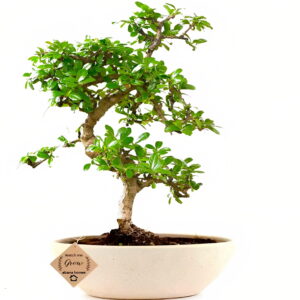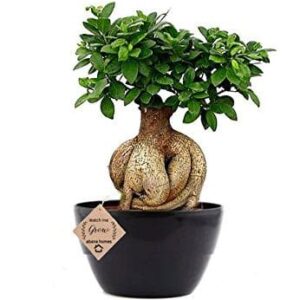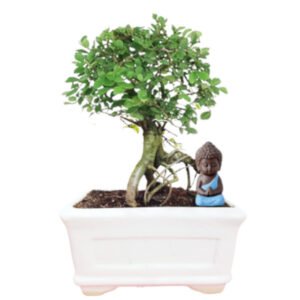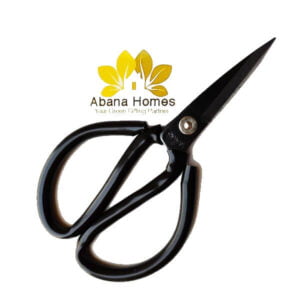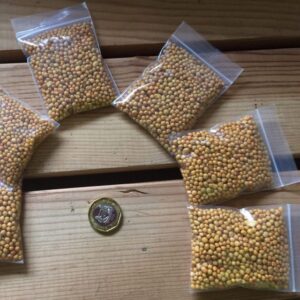
If anyone asks what is the most popular bonsai to our experts, there’s only one answer: Chinese Elm Bonsai Tree and I think this will be the same case for any other bonsai outlets there in the market. The popularity of this bonsai is not recent, this species has been regarded as the primary bonsai species for centuries and continues to delight both new bonsai owners and experts. The rich meaning and the history of this bonsai species make it ideal for keeping in your space or gifting it to somebody you adore.
In this article, we will take a detailed look at the Chinese elm bonsai tree. Let’s learn more about this magnificent specimen
-
Bonsai Plants, Chinese Elm Bonsai, Outdoor Bonsai Tree, Outdoor Plants
MRP: Original price was: ₹2,000.00.₹1,399.00Current price is: ₹1,399.00. -
MRP: Original price was: ₹2,000.00.₹1,399.00Current price is: ₹1,399.00.
-
Bonsai Plants, Ficus Bonsai Plants, Indoor Bonsai Tree
MRP: Original price was: ₹1,500.00.₹1,100.00Current price is: ₹1,100.00. -
Bonsai Plants, Carmona Bonsai Plants, Flowering Bonsai Plants, Indoor Bonsai Tree
MRP: Original price was: ₹2,100.00.₹1,499.00Current price is: ₹1,499.00. -
Bonsai Plants, Chinese Elm Bonsai
MRP: Original price was: ₹1,500.00.₹1,099.00Current price is: ₹1,099.00. -
Bonsai Plants, Exotic Bonsai Plants & Trees, Outdoor Bonsai Tree
MRP: Original price was: ₹1,999.00.₹1,699.00Current price is: ₹1,699.00. -
Bonsai Plants, Carmona Bonsai Plants
MRP: Original price was: ₹4,600.00.₹2,999.00Current price is: ₹2,999.00. -
Bonsai Tools, Bonsai Soil, Soil & Fertilizers
MRP: ₹199.00 – ₹699.00 -
MRP: Original price was: ₹300.00.₹199.00Current price is: ₹199.00.
-
Soil & Fertilizers, Bonsai Tools
MRP: Original price was: ₹300.00.₹199.00Current price is: ₹199.00.
Chinese Elm Bonsai Tree and its Varieties:
Chinese elm bonsai is a wonderfully stunning bonsai. The leaves are tiny, brilliant to dark green, and somewhat serrated. The tree has a superb twig format and a strong personality throughout, giving it an ideal replica of a wood tree. There are different types of cultivars that are grown from the parent plant. They’re common in characteristics too, so you can only choose by the aesthetics. Here are some of those common types;
Allee Chinese elm: They grow tall in an upright fashion. The bark of the tree possesses different colours such as tan, brown, grey, and orange.
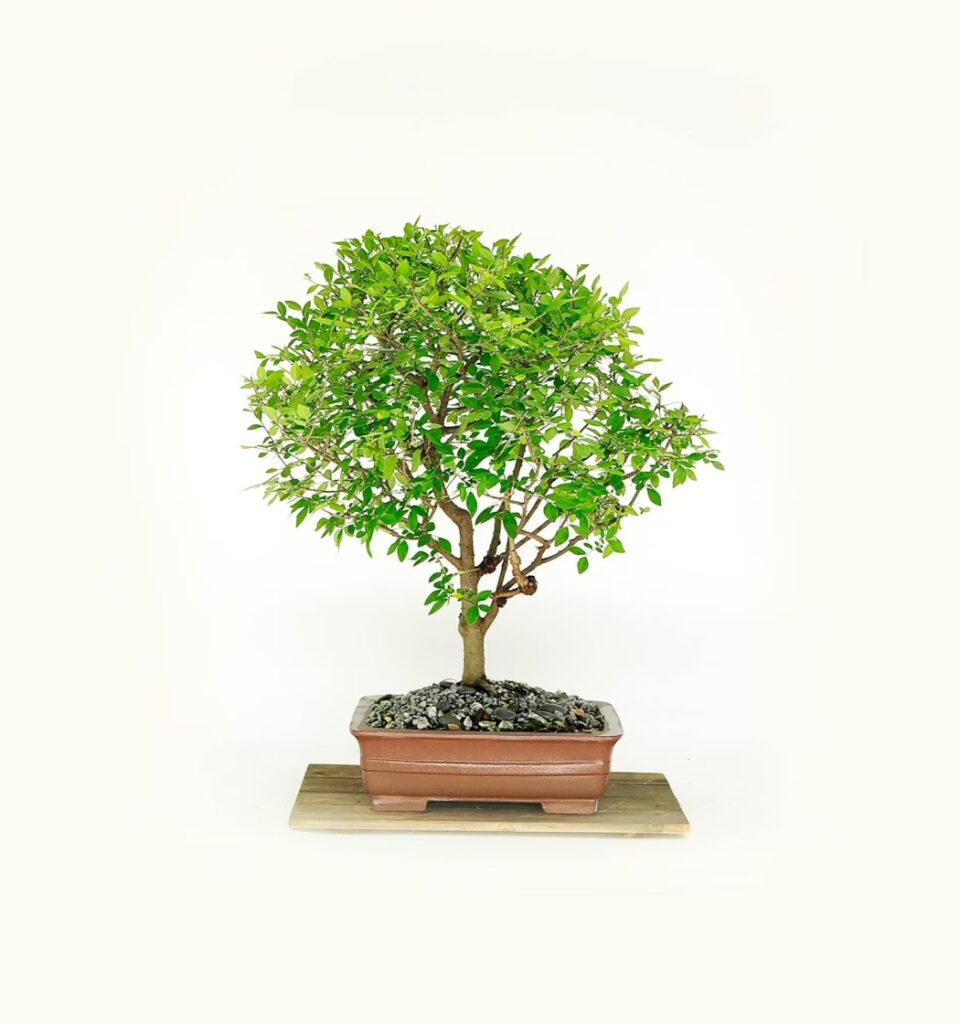
Athena classic elm: They grow tall and in upright style like their other siblings. In autumn the green leaves will turn copper and bronze.
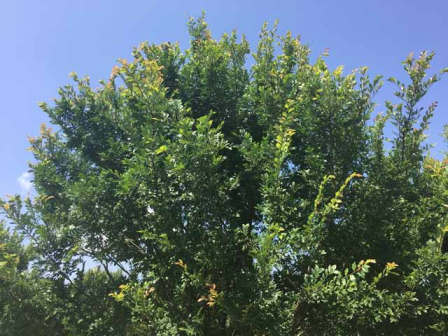
Bosque Chinese elm: They grow in the same fashion as their siblings. The green leaves will turn into bright, eye-catching purple in fall.

Drake Chinese elm: The leaves of the tree are almost evergreen. In comparison to other species, they are the most hardy.

Everclear Chinese elm: This tree grows in a tall, narrow, and upright fashion. Their leaves are small and have a leather-like texture. They are also hardy like Drake Chinese elm, they can tolerate all kinds of soil conditions as long as it is well-draining.
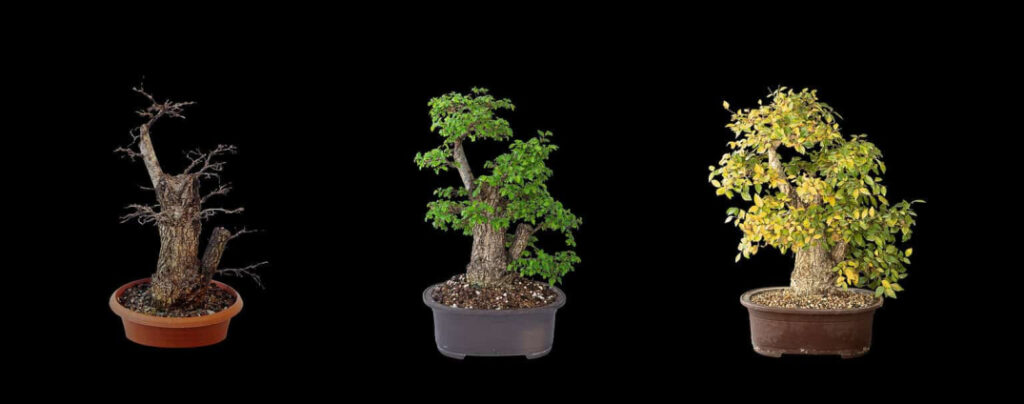
Seasonal changes in Chinese elm
The rich history of the Chinese Elm bonsai Tree:
Being native to Asian countries like Japan, Vietnam, China, and India they were popular as both wild and bonsai trees in those areas, but their worldwide fame came when America gave them priority. They have an interesting connection with the mystical tree.
Even though bonsai Chinese Elm entered the United States in the 1800s as travellers imported trees, bonsai, and cuttings there, it didn’t get the limelight as American Elm was everywhere during that time. After dominating for centuries, sadly in 1928 they got affected by the Asian Elm Beetles. These beetles caused Dutch Elm Disease (DED), a fungal spore that killed American elms.
It was then that US scientists and botanists discovered that the Chinese Elm was extremely resistant to the disease. Even bonsai remained healthy as DED spread across the United States before officials could prevent it. The lace-bark elm became extremely popular at the time. The Chinese elm bonsai tree also became the most popular of the elm trees for bonsai practice.
The Symbolism of Chinese Elm Bonsai:
This hardy bonsai symbolises harmony and it is believed that it will help you achieve a balance in all aspects of life. If you have noticed the tree in the wild you will notice the canopy spreads evenly all around the tree and it is believed that if you grow the tree in an informal upright style it will give the same effect. This equal spreading of canopy symbolises balance in life.
The secondary symbols of the Chinese elm bonsai tree are wisdom, vitality, and intuition.
The tree also passes on the positive energy of calm, love, and inner strength to us. All these positive aspects also make bonsai high on the list of bonsai enthusiasts.
Why Do Every Bonsai Owners Love Chinese Elm Bonsai?
Bonsai Chinese Elm is the perfect species for bonsai tree cultivation, they are beautiful, sturdy, have a long lifespan, and are adaptable. Here are five reasons why they are preferred most by both beginners and experts;
1) Beginner Friendly:
The practice of bonsai makes the tree vulnerable as there is heavy wiring involved, so negligence will kill it. People who are just starting out with bonsai are scared of this fact. However, the Chinese elm bonsai tree is the safest option in this case as it is hearty and can survive negligence better than other species.
2) Beautiful Curves:
One of the primary goals of bonsai practice is to make it look like they look mature and survive natural disasters in the wild. The bonsai Chinese elm delivers this in spades. It naturally grows with elegant curves which give it the “windswept” look effortlessly.
3) Easy to train:
The Chinese Elm is ideal for new bonsai lovers. It’s simple to train with wires and cuts, and it’s stronger than many other species.
It is true that many beginners accidentally kill their first Bonsai, but do not be discouraged. Training a Bonsai requires practice, and the bonsai Chinese Elm improves your chances of success.
4) Lush Foliage:
The tree will be covered with lush, green, tough foliage most of the time. Chinese elm bonsai is semi-deciduous and will lose most of its leaves in winter, but don’t panic, it will be lively again in spring.
5) Indoor and outdoor options:
We had saved the best reason for the last. Chinese elm bonsai is almost equal in both indoor and outdoor settings. But if you are keeping inside your house make sure that they receive lots of natural light as they thrive in it. If you keep the bonsai outside make sure your winter area is frost-free at night as they are from warm areas and don’t do well in frost. Other than that they will thrive with very less difficulty.
| Reasons | Details |
| Beginner friendly | Hearty and can survive negligence better than other species. |
| Beautiful curves | Naturally grows with elegant curves, can achieve a “windswept” look naturally. |
| Easy to train | Simple to train with wires and stronger than many other species. |
| Lush Foliage | Covered with lush, green, tough foliage most of the time. |
| Indoor/outdoor option | Thrives in both indoor and outdoor settings. |
Chinese elm bonsai care:
Location:
The Chinese Elm is a low-maintenance bonsai that prefers a place with plenty of natural light but avoids direct sunlight, especially during the hottest summer months. A window sill is ideal, but avoid south-facing window sills in the middle of summer.
Temperature:
The Chinese Elm is tolerant to different temperature ranges as an indoor bonsai. If you’re growing your bonsai outside, make sure it’s in a sheltered area of the garden. For really cold nights (below freezing), we recommend moving the bonsai into a shed, glasshouse, or cold frame.
Water:
Chinese elms prefer slightly damp soil. Allow the soil to dry out slightly between waterings. Both drought and permanent dampness should be avoided. To determine when it’s time to water, insert your finger a half-inch deep in the dirt and feel the dryness. Avoid prolonged soil dryness. Mist your Chinese Elm Bonsai Tree a few times per week to control humidity.
Feeding:
Use a well-balanced fertiliser like NPK 19:19:19 or an Organic Fertiliser like Vermicompost once a month.
Repotting:
Younger Chinese Elms should be repotted every two years, older and larger specimens can be repotted in longer intervals. While repotting use a proper drainage soil mixture.
Pruning:
Pruning is necessary to maintain the right shape of your bonsai and also to encourage new growth. Allow shoots to extend to 3 or 4 nodes and then prune back to 1 or 2 leaves. You can prune any time of the year, but will advise you to avoid winter as the growth will be slow as is the recovery of heavy pruning mistakes.
Chinese elm bonsai care chart;
| Daily | Weekly | Monthly/Yearly |
| Check the moisture of the soil and water when the upper part is slightly dry.Make sure it’s getting a good amount of natural light. | Check the tree for any signs of disease or pests.Clean the dust from the leaves with a soft wet cloth. | Re-pot the tree every 1-2 years depending on the growth of the roots. Apply organic fertiliser once a month from spring through fall.Prune the tree whenever it’s necessary. |
Ideal Chinese elm bonsai styles:
You can easily recreate these three popular bonsai tree styles;
1) Chokkan Style:

The Chokkan style is the most popular Bonsai tree style for Chinese elms. This design, often known as the formal upright style, is appropriate for Chinese elm Bonsai trees because it is how they naturally grow.
2) Moyogi Style:

The Moyogi style is another option for shaping your Chinese elm Bonsai tree. The casual upright style involves forming your tree into a wavy shape. It often resembles the letter S.
3) Sokan Style:

Chinese elm bonsai trees can also be styled like Sokan. This design, like the Chokkan, has trees that grow upright. The sole distinction is that Sokan-style bonsai trees have two trunks.
If you are planning to be a bonsai owner, Chinese elm bonsai will be a great starting point. Start with one and later you can expand it in a bonsai garden where every bonsai in your collection can have their own characteristics in terms of formation. Before wrapping up we will address some of the frequently asked questions;
1) What are some of the common challenges growing Chinese elm bonsai?
Ans: The tree is mainly known for its fuss-free nature but a few challenges can still arise. Firstly, overwatering, if the tree is sitting in damp soil constantly it can rot the root and if ignored for a long time it will end up killing the entire tree. Secondly, temperature fluctuations can put them under stress. Thirdly, pests and diseases, spider mites, and aphids are those inevitable pests that can attack any tree in their vulnerable situations. You need to check the tree at least once a week for any sign of pests or fungus.
2) How often should I water my Chinese elm bonsai?
Ans: In general rule of thumb is water when the topsoil is slightly dry. Water over the soil instead of springing water over the tree. Make sure the drainage is good. Even though they need water every day in summer and once every three days in winter it’s ideal to follow your own observation instead of a clear-cut routine.
3) What kind of environment does the bonsai Chinese elm prefer?
Ans: The tree is originally from a warm environment and prefers similar conditions. They don’t like cold weather. If where you live gets frizzy at night it is advisable to keep it inside a greenhouse or a heated garage.


